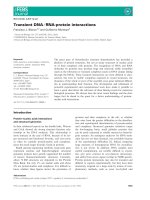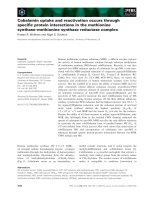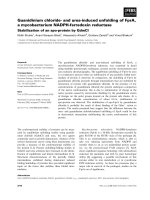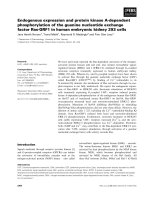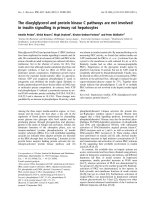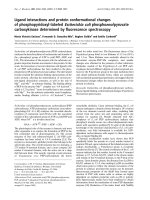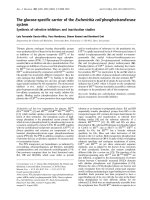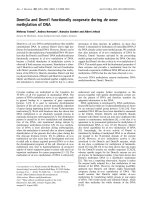Tài liệu Báo cáo Y học: Ligand interactions and protein conformational changes of phosphopyridoxyl-labeled Escherichia coli phosphoenol pyruvate carboxykinase determined by fluorescence spectroscopy pdf
Bạn đang xem bản rút gọn của tài liệu. Xem và tải ngay bản đầy đủ của tài liệu tại đây (379.37 KB, 9 trang )
Ligand interactions and protein conformational changes
of phosphopyridoxyl-labeled
Escherichia coli
phospho
enol
pyruvate
carboxykinase determined by fluorescence spectroscopy
Marı
´
a Victoria Encinas
1
, Fernando D. Gonza
´
lez-Nilo
1
, Hughes Goldie
2
and Emilio Cardemil
1
1
Departamento de Ciencias Quı
´
micas, Facultad de Quı
´
mica y Biologı
´
a, Universidad de Santiago de Chile, Chile;
2
Department of
Microbiology and Immunology, University of Saskatchewan, Saskatoon, Canada
Escherichia coli phosphoenolpyruvate (PEP) carboxykinase
catalyzes the decarboxylation of oxaloacetate and transfer of
the c-phosphoryl group of ATP to yield PEP, ADP, and
CO
2
. The interaction of the enzyme with the substrates ori-
ginates important domain movements in the protein. In this
work, the interaction of several substrates and ligands with
E. coli PEP carboxykinase has been studied in the phos-
phopyridoxyl (P-pyridoxyl)-enzyme adduct. The derivatized
enzyme retained the substrate-binding characteristics of the
native protein, allowing the determination of several pro-
tein–ligand dissociation constants, as well as the role of
Mg
2+
and Mn
2+
in substrate binding. The binding affinity
of PEP to the enzyme–Mn
2+
complex was )8.9 kcalÆmol
)1
,
which is 3.2 kcalÆmol
)1
more favorable than in the complex
with Mg
2+
. For the substrate nucleotide–metal complexes,
similar binding affinities ()6.0 to )6.2 kcalÆmol
)1
)were
found for either metal ion. The fluorescence decay of the
P-pyridoxyl group fitted to two lifetimes of 5.15 ns (34%)
and 1.2 ns. These lifetimes were markedly altered in the
derivatized enzyme–PEP–Mn complexes, and smaller
changes were obtained in the presence of other substrates.
Molecular models of the P-pyridoxyl–E. coli PEP carb-
oxykinase showed different degrees of solvent-exposed sur-
faces for the P-pyridoxyl group in the open (substrate-free)
and closed (substrate-bound) forms, which are consistent
with acrylamide quenching experiments, and suggest that the
fluorescence changes reflect the domain movements of the
protein in solution.
Keywords: Escherichia coli phosphoenolpyruvate carboxy-
kinase; ligand binding; conformational changes; P-pyridoxyl
fluorescence spectroscopy.
Escherichia coli phosphoenolpyruvate carboxykinase [PEP
carboxykinase; ATP:oxaloacetate carboxylase (trans-phos-
phorylating) EC 4.1.1.49] catalyzes the reversible decarb-
oxylation of oxaloacetic acid (OAA) with the associated
transfer of the c-phosphoryl group of ATP to yield PEP and
ADP, where M
2+
is a divalent metal ion:
OAA þ ATP !
M
2þ
PEP þ ADP þ CO
2
The physiological role of this enzyme in bacteria and most
other organisms is to catalyze the formation of PEP in the
first committed step of gluconeogenesis [1]. The crystal
structure of free- and substrate-bound E. coli PEP carb-
oxykinase has been solved at 1.9 A
˚
resolution [2,3]. The
enzyme is a monomeric, globular protein that belongs to the
a/b protein class. The overall structure has two domains, a
275 residue N-terminal domain, and a more compact 265
residue C-terminal domain, with the active site in a deep
cleft between them. The recently reported crystal structure
of Trypanosoma cruzi PEP-carboxykinase [4] shows
remarkable similarity. Upon substrate binding, the E. coli
enzyme undergoes a domain closure through a 20° rotation
of the two domains towards each other, excluding bulk
solvent from the active site and positioning active site
residues for catalysis [3]. Results obtained with AlF
3
complexes of E. coli PEP carboxykinase indicate that
phosphoryl transfer occurs via a direct displacement mech-
anism with associative qualities [5]. In spite of the detailed
knowledge of the structural characteristics of E. coli carb-
oxykinase, very little information is available for ATP-
dependent carboxykinases with respect to thermodynamic
data on ligand binding [6].
Chemical modification studies have shown that PLP
specifically labels the protein in a lysyl residue located at
position 288 and, upon reduction of the labeled enzyme with
sodium borohydride, a P-pyridoxyl group is covalently
attached at this site [7]. The crystal coordinates of the E. coli
enzyme indicate that this residue, located in the C-terminal
domain, is 9.7 A
˚
from Gly251, which is the closest amino
acid residue of the N-terminal domain, in the P-loop of the
enzyme. Upon domain closure, the distance from Lys288 to
Gly251 reduces to 5.3 A
˚
, thus making Lys288 an excellent
observation point to follow the domain movement of the
protein in solution, provided this motion can be detected.
Spectroscopic properties of the Schiff base formed upon
reaction of PLP with amino acids or amines are highly
dependent on medium properties such as pH or polarity
[8,9]. Spectroscopic studies have been employed to obtain
information about the mechanism of some PLP-dependent
enzymes [10]. Reduction of the imine bond with NaBH
4
Correspondence to M. V. Encinas, Departamento de Ciencias
Quı
´
micas, Facultad de Quı
´
mica y Biologı
´
a, Universidad
de Santiago de Chile, Casilla 40, Santiago 33, Chile.
Fax: + 56 2 681 2108, Tel.: + 56 2 681 2575;
E-mail:
Abbreviations: OAA, oxaloacetic acid; PEP, phosphoenolpyruvate;
PLP, pyridoxal 5¢-phosphate; P-pyridoxyl, phosphopyridoxyl.
(Received 16 May 2002, revised 26 July 2002,
accepted 21 August 2002)
Eur. J. Biochem. 269, 4960–4968 (2002) Ó FEBS 2002 doi:10.1046/j.1432-1033.2002.03196.x
attaches the probe covalently to the protein, thus providing
a suitable probe to detect structural conformational chan-
ges, as its spectroscopic features are also expected to be
highly dependent on the medium properties.
In this work we took advantage of the specific labeling
with PLP of Lys288 in E. coli PEP carboxykinase to gain
insight into conformational alterations of the protein upon
ligand binding in solution. Analysis of the fluorescent
characteristics of the reduced Schiff base allowed us to
obtain binding constants for the interaction of several
substrates and ligands, and the role of metal ions on their
binding.
EXPERIMENTAL PROCEDURES
Materials
PLP, NaBH
4
, NaCNBH
3
, PEP, nucleotides, MnCl
2
,
MgCl
2
, and pyridoxamine were from Sigma Chemical
Co., OAA from Boehringher Mannheim, oxalate from
Merck. Recombinant E. coli PEP carboxykinase was
obtained as described [11]. All other reagents were of the
purest commercially available grade.
Labeling of
E. coli
PEP carboxykinase with PLP
The enzyme (25–30 l
M
) was reacted with a fourfold molar
excess of PLP for 5 min at 0 °Cin50m
M
Hepes (pH 7.5)
containing 3 m
M
NaCNBH
3
. The reaction was stopped
with 100 m
M
NaBH
4
, and excess reagents eliminated by
dialysis at 4 °C against 50 m
M
Hepes (pH 7.0). Under these
conditions, PLP specifically reacts with Lys288 [7]. Labeling
stoichiometries, determined from e
280
¼ 67 700
M
)1
Æcm
)1
for E. coli PEP carboxykinase [2,12] and e
325
¼
9710
M
)1
Æcm
)1
for the P-pyridoxyl group [8], were in the
range 0.8–1.0 mol P-pyridoxyl/mol of protein.
Fluorescent measurements
All measurements were carried out at 22 °Cin50 m
M
Hepes
buffer (pH 7.0). Steady state fluorescence measurements
were performed on a Spex Fluorolog spectrofluorometer
with excitation and emission band width of 1.25 nm. The
excitation wavelength to follow the tryptophan fluorescence
was 295 nm, while 325 nm were used for the P-pyridoxyl
fluorescence. All spectra were recorded using the corrected
mode. Fluorescence lifetimes were measured with an
Edinburgh Instruments OB 900 time correlated single
photon counting fluorimeter, using a hydrogen filled lamp
for excitation. Fluorescence quenching experiments with
acrylamide were carried out by monitoring the decrease in
intensity at the emission maximum wavelength or the
change in the fluorescence lifetimes. Successive aliquots of
freshly prepared solutions (5.6
M
)wereaddedtoacell
containing the protein, and the respective parameter was
measured. Appropriate corrections were made for dilution
effects (never exceeding 10%). The quenching data were
fitted to the Stern–Volmer equation,
F
=F ¼ 1 þ K
SV
½Qð1Þ
where F ° and F are the fluorescence intensities in the
absence and presence of quencher, respectively. K
SV
is
the Stern–Volmer constant, which is related to the
bimolecular quenching rate constant (k
q
) and the
lifetime of the singlet excited state in the absence of
quencher (s°)byK
SV
¼ k
q
Æs°. Values of k
q
were calcu-
lated using the amplitude average lifetimes Æ sæ ¼ Sf
i
s
i
,
where f
i
is the amplitude fraction.
The effect of ligands was analyzed by monitoring the
change of fluorescence intensity upon ligand addition to
protein solutions. OAA solutions were prepared just before
the experiments. The decomposition of OAA under our
experimental conditions was determined using the lactic
dehydrogenase assay [13], and was lower than 12%.
Concentration of CO
2
is expressed as total bicarbonate.
The dissociation equilibrium constants (K
d
)ofthe
protein–ligand (LP) complexes were evaluated by the curve
fitting to the quadratic equation deduced from the equilib-
rium L + P , LP, considering that LP is proportional to
the emission intensity changes.
Y
F
¼ðF
obs
À F
o
Þ=ðF
1
À F
o
Þ¼½ðP þ L þ K
d
Þ
ÀððP þ L þ K
d
Þ
2
À 4P ðLÞ
1=2
=2P ð2Þ
Where F
obs
is the measured fluorescence intensity, F
o
is
the fluorescence intensity at the start of the titration, F
¥
is the fluorescence intensity at saturating concentration
of ligand, P the total protein concentration, and L is
referred to the ligand concentration.
The distribution of metal ion as [M
2+
]
free
, [ML]
and of [L]
free
was calculated using the dissociation con-
stants for the individual species present. The values used
were MnÆoxalacetate ¼ 1.2 · 10
)2
M
[14], MnÆoxa-
late ¼ 1.78 · 10
)4
M
, MgÆoxalate ¼ 4.17 · 10
)3
M
[15]
MnATP
2–
¼ 1.5 · 10
)5
M
, MnHATP
–
¼ 2.2 · 10
)3
M
,
MgATP
2–
¼ 6.3 · 10
)5
M
, MgHATP
–
¼ 4.8 · 10
)3
M
,
MnADP
–
¼ 8.1 · 10
)5
M
, MnHADP ¼ 1.3 · 10
)2
M
,
MnAMP ¼ 4.3 · 10
)3
M
, MnPEP
–
¼ 5.5 · 10
)3
M
,
MgPEP
–
¼ 1.8 · 10
)3
M
[16]. For MnGDP
–
and MnHGDP
the values of the corresponding ADP complexes were used.
The concentration of the different species at pH 7.0 was
calculated using the program
COMPLEX
version 6 (1986)
written by A. Cornish-Bowden, Centre National de la
Recherche Scientifique, Marseille, France.
Computer-assisted three-dimensional modeling
The programs
INSIGHTII
and
DISCOVER
972 (MSI) were used
on an O2 SGI workstation to obtain the three-dimensional
models of E. coli PEP carboxykinase. The structures
analyzed were E. coli PEP carboxykinase (1OEN) [2] and
the E. coli PEP carboxykinase–Mg
2+
-Mn
2+
–ATP–pyru-
vate complex (1AQ2) [3]. Amino acids lost in crystallo-
graphic data were inserted into each structure. All
calculations were carried out with
DISCOVER
_3 (MSI) and
force field CVFF and ESFF (MSI), that has all parameters
needed for the octahedral Mn
2+
coordination and amino
acids (1AQ2). This program was also employed for energy
minimization and molecular dynamics. The metal ion
Mg
2+
was replaced by Mn
2+
in octahedral coordination
to three water molecules, a bidentate coordination to two
oxygen atoms from P
b
and P
c
of ATP, and the oxygen of the
hydroxyl group of Thr255. The second Mn
2+
was in
octahedral coordination to two water molecules, an oxygen
atom from P
c
of ATP, N
e2
from His232, an oxygen atom
from the side chain of Asp269, and N
e
from Lys213.
Ó FEBS 2002 Ligand interactions of PEP carboxykinase (Eur. J. Biochem. 269) 4961
N
e
from Lys288 of the open structure was covalently linked
to carbonyl group of PLP through an imino linkage. Then,
the best position of the P-pyridoxyl group was selected by
performing an energy barrier calculation of the dihedral
angle C-Ne-O-P [17], and the resulting structure was relaxed
using a cycle of simulated annealing. Initially, the system
was gradually heated from 200 to 500 K, with increments of
37.5 K for 5 ps each. Then, the system was equilibrated at
500 K by 10 ps, and finally cooled to 200 K, decreasing 10 K
each 5 ps (30 steps). The relaxed structure obtained was
finally minimized using steepest descents and conjugate
gradients algorithms. This final position for the P-pyridoxyl
group was used as a starting structure in the closed E. coli
PEP carboxykinase model, and then it was minimized using
a simulated annealing by 200 ps. The cutoffs for van der
Waals and Coulombic interactions were 10 A
˚
and 12 A
˚
,
respectively. Using both final structures, the solvent acces-
sible surface area of the P-pyridoxyl group and of active site
residues were calculated using a solvent radius of 1.4 A
˚
(water). For the amino acids, the fraction of solvent
accessible surface area was calculated using the Gly-X-Gly
tripeptide model implemented in
INSIGHTII
[18]. The residues
on either side of the index residue are mutated to glycine,
and the solvent accessible surface area for the index residue
is calculated (reference value for 100% solvent accessible
surface). The reference value for each residue is dependent
on the conformation of the neighboring residues.
RESULTS
Characteristics of the P-pyridoxyl group linked
to
E. coli
PEP carboxykinase
Free pyridoxamine, which can be considered as a model of a
pyridoxyl group bound to a Lys residue, exhibits an
absorption spectrum with a maximum at 326 nm at pH 7
and 20 °C. This band can be assigned to the bipolar form of
the pyridoxamine [8], as consequence of the deprotonation of
the phenolic group. Upon excitation at 326 nm, pyridoxam-
ine shows a well shaped emission band centered at 393 nm at
pH 7. The absorption spectrum of the P-pyridoxyl adduct of
PEP carboxykinase exhibits a band with a maximum at
326 nm due to pyridoxyl moiety and a band at 280 nm
corresponding to the aromatic amino acids of the protein.
The fluorescence of the P-pyridoxyl moiety bound to the
protein at pH 7 is similar to that of free pyridoxamine, with a
maximum at 393 nm. This spectral behavior reflects a high
degree of exposure of the P-pyridoxyl group to the solvent.
The fluorescence decay of pyridoxamine and of the
P-pyridoxyl-labeled protein were monitored at 393 nm
upon excitation at 326 nm. The emission decay of pyridox-
amine was monoexponential with a lifetime of 1.83 ns, while
that of P-pyridoxyl bound to the protein could only be fitted
by two exponential decays of 5.15 ns and 1.21 ns, with
fractional intensities of 0.34 and 0.66, respectively (Fig. 1).
This heterogeneous emission decay indicates that the
pyridoxyl chromophore senses microheterogeneous envi-
ronments during its lifetime due to its localized motion, to
relaxation processes involving the solvent, and/or adjacent
residues on the protein surface.
To get an approximation of the steric relationships
between the Lys288-bound P-pyridoxyl group and the
protein structure, the corresponding complex was modeled
using the crystalline coordinates of the free E. coli PEP
carboxykinase [2]. The deviation of the resulting model
structure (P-pyridoxyl labeled protein) from the coordinates
of the starting structure (PDB: 1OEN), give a r.m.s. value of
0.95 A
˚
for Ca. Figure 2 shows that the P-pyridoxyl group is
located close to active site in a position that allows the access
of substrates to the active site. When the amino acid residues
located £ 4A
˚
from ATP and the two metal ions were
considered, it was found that in the open, ligand-free
structure, the P-pyridoxyl group does not overlap any
residue except the Thr251, which corresponds to only 4.7%
of the total solvent accessible area considered. The Thr251 is
a noncatalytic residue close to C2¢ of ATP. Thus, this
location makes this chromophore a suitable probe to sense
conformational changes that occur in this protein region
upon substrate binding.
Effect of ligands on the P-pyridoxyl fluorescence
The addition of metal ions or substrates to the labeled
enzyme caused marked changes in the emission character-
istics of the bound P-pyridoxyl group (Fig. 3). The addition
of Mn
2+
quenched the fluorescence. However, the addi-
tion of PEP or ATP in the presence of saturating
concentrations of Mn
2+
increased the fluorescence
intensity. These fluorescence variations suggest that
Fig. 1. Fluorescence decay profiles of P-pyridoxyl bound to the E. coli
PEP carboxykinase in Hepes pH 7.0, k
exc
¼ 326 nm, k
em
¼ 393 nm (a)
in absence of substrates; (b) in the presence of 1 m
M
PEP plus 2 m
M
Mn
2+
(c) instrumental response function. The solid line corresponds to
a biexponential function with s
1
¼ 5.15 ns (34%), s
2
¼ 1.21 ns for the
enzyme–adduct in the absence of substrate, and s
1
¼ 6.10 ns (51%),
and s
2
¼ 1.14 ns in the presence of PEP and Mn
2+
. Bottom: distri-
bution of residuals.
4962 M. V. Encinas et al. (Eur. J. Biochem. 269) Ó FEBS 2002
conformational changes caused by the ligand are easily
sensed by the P-pyridoxyl chromophore. Figure 4 shows the
modeled structure of the P-pyridoxyl-PEP carboxykinase in
the free and substrate bound conformations. In the open
conformation (Fig. 4A), the P-pyridoxyl moiety is rather
solvent exposed with a fractional exposed area of 0.39,
meanwhile in the closed conformation (Fig. 4B) the exposed
area is 0.082, indicating that the fluorophore is now almost
completely hindered into the protein matrix.
The addition of Mn
2+
, an essential metal ion for
catalysis, to the labeled PEP carboxykinase caused the
quenching of the fluorescence signal without any shift of the
spectrum. The pattern of fluorescence quenching by Mn
2+
was biphasic (Fig. 5). The first phase occurred approxi-
mately in the range from 0 to 0.3 m
M
Mn
2+
, whereas the
second phase implies a lower quenching that occurred at
millimolar concentrations of the metal ion. This biphasic
behavior indicates the presence of binding sites with
different affinities. Data of fluorescence intensity as function
of Mn
2+
concentration (Fig. 5) were well fitted to Eqn (2),
expressed as a double binding function. Values of K
d
of
17.4 l
M
and 1.4 m
M
were obtained for the high and low
affinity binding sites, respectively (Table 1). When similar
experiments were carried out with Mg
2+
, fluorescence
quenching was observed only at metal ion concentrations in
the millimolar range, and the data were well fitted to a
monophasic saturation curve with K
d
of 1.8 m
M
.These
results imply a low affinity site for the magnesium cation in
the protein.
The incubation of the labeled enzyme with increasing
concentrations of adenine nucleotides in the presence of
Mn
2+
led to a progressive enhancement of the emission,
and to a blue shift of approximately 4 nm in the emission
maximum. The increase of the fluorescence intensity gave a
monophasic saturation curve. Data obtained for different
nucleotides are displayed in Fig. 6A. The dissociation
constants, calculated assuming that nucleotides bind as
nucleotide–metal complex [3,19], are given in Table 1. These
values show similar affinities for MnATP and MnADP, and
much lower affinity for the metal monophosphorylated
nucleotide derivative (Table 1). This is in agreement with
the expected requirement of the b-andc-phosphate groups
of the nucleotide for efficient binding to the protein active site
[20]. Binding affinity of MgATP was similar to that in the
presence of Mn
2+
, and also similar to previous determina-
tions of ATP and ADP binding to the native E. coli PEP
carboxykinase [6]. On the other hand, the addition of ATP or
ADP in the absence of metal ions gave emission changes at
much higher nucleotide concentrations, suggesting binding
to low affinity, noncatalytic sites. The addition of GDP in the
presence of Mn
2+
to the labeled protein produced changes in
the fluorescence emission only at high concentrations
(Fig. 6A), as expected from the known specificity of the
E. coli PEP-carboxykinase for adenosine nucleotides [20,21].
Thus, results obtained from nucleotide binding to the
P-pyridoxyl-labeled enzyme, show that the enhanced
emission in the presence of ADP or ATP can only be a
consequence of conformational changes caused by the
binding of the nucleotide to the enzyme active site region.
Binding of CO
2
(expressed as total bicarbonate), another
substrate of the enzyme, also increased the P-pyridoxyl
fluorescence. The addition of this substrate to the protein
blue shifted the maximum by 5 nm and the fluorescence
Fig. 3. Steady state fluorescence spectra of 2 l
M
P-pyridoxyl-E. coli
PEP carboxykinase using k
exc
¼ 326 nm, in the presence of different
combinations of substrates and metal ions: (a) in the absence of ligands;
and in the presence of (b) 2 m
M
Mn
2+
(c) 1 m
M
ATP plus 2 m
M
Mn
2+
(d) 0.05 m
M
PEP plus 1 m
M
Mn
2+
.
Fig. 2. Molecular model of the P-pyridoxyl-E. coli PEP carboxykinase
adduct. N
e
from Lys288 of the open structure of E. coli PEP carb-
oxykinase (1OEN) is covalently linked to the carbonyl carbon of the
P-pyridoxyl group (PL) through an imino linkage. The green line
shows the protein backbone, the P-pyridoxyl group is shown in yellow.
The Connelly surface of the active site residues is shown in magenta.
Ó FEBS 2002 Ligand interactions of PEP carboxykinase (Eur. J. Biochem. 269) 4963
increased 1.52-fold. Interestingly, CO
2
binding was not
affected by the presence of cations. The saturation curves in
the absence or presence of Mn
2+
were similar, K
d
in the
presence of Mn
2+
was 13.7 m
M
which is close to the
apparent K
m
for HCO
3
–
(13 m
M
) [21]. Also, a similar
dissociation constant of 8.2 m
M
has been determined for the
enzyme–CO
2
complex of homologous Saccharomyces cere-
visiae PEP carboxykinase [22].
The addition of PEP to the labeled protein in the absence
of divalent cations produced no changes in the emission
properties of the P-pyridoxyl chromophore. However, in the
presence of saturating concentrations of Mn
2+
, micromolar
concentrations of PEP produced notable changes on the
P-pyridoxyl fluorescence (Fig. 6B). The intensity increased
almost threefold and the emission maximum was blue
shifted by 10 nm. The fitting of data to Eqn (2) using the
free PEP concentration gave K
d
value of 0.25 l
M
(Table 1)
.
Fluorescence data using the MnPEP concentration did not
fit to Eqn (2). Binding of PEP in the presence of Mg
2+
was
also accompanied by the enhancement of the fluorescence
intensity and a spectral shift of 7 nm. However, the
dissociating constant was two orders of magnitude higher
than that obtained in the presence of Mn
2+
(Table 1).
An independent estimation of the binding affinity of PEP
for E. coli PEP carboxykinase was obtained from the
quenching of the emission of Trp residues of the unlabeled
protein. When the protein was titrated with PEP in the
presence of saturating concentrations of Mn
2+
, the intrinsic
fluorescence was quenched by 10%. In spite of this small
effect of PEP on the Trp emission, the fluorescence decrease
as function of free PEP concentration gave a saturating plot
thatfittedtoEqn(2)withaK
d
of 0.22 l
M
(Table 1). This
value is similar to that obtained using the modified enzyme.
This indicates that both types of signals, Trp and P-pyri-
doxyl fluorescence, monitor the same process. Furthermore,
this indicates that derivatizing PEP-carboxykinase with
Fig. 4. Space-filling diagrams of the P-pyri-
doxyl-E. coli PEP carboxykinase adduct in the
open (A) and closed (B) structures. The N-ter-
minal domains of the two structures are
colored yellow, and the C-terminal domains
green. The phosphoryl and pyridoxyl moieties
of the P-pyridoxyl group are shown in red and
magenta, respectively. The fractional solvent
exposed area of the P-pyridoxyl group is 0.39
and 0.082 for the open and closed structures,
respectively. The molecular models for (A)
and (B) are based on PDB structures 1OEN
and 1AQ2, respectively.
Fig. 5. Changes in the fluorescence of P-pyridoxyl-E. coli PEP carb-
oxykinase (3 l
M
)asfunctionofMn
2+
concentration. The solid line
represents the fitting of data to Eqn (2) expressed as a double binding
function.
Table 1. Dissociation equilibrium constants for the ligand-protein com-
plexes.
Ligand Metal ion
a
K
d
(l
M
)
Mn
2+
– 17.4 ± 3.6 (40 ± 6)
b
1400 ± 480
Mg
2+
– 1800 ± 380
ATPMn Mn
2+
24 ± 1.0
ATPMg Mg
2+
33.8 ± 2.0 (10 ± 1)
b
ADPMn Mn
2+
24.8 ± 1.0 (18 ± 2)
c
AMPMn Mn
2+
128 ± 7
GDPMn Mn
2+
508 ± 37
PEP Mn
2+
0.24 ± 0.02 (0.21 ± 0.08)
c
PEP Mg
2+ d
53.8 ± 4.4
CO
2
– 10 300 ± 350
CO
2
Mn
2+
13 700 ± 600
Oxalacetate Mn
2+
156 ± 17
Oxalate Mn
2+
26 ± 2
Oxalate Mg
2+ d
136 ± 16
a
Metal ion concentration was 2 m
M
in all cases.
b
From [6], cal-
culated from the Trp fluorescence quenching in the unlabeled
enzyme.
c
This work, calculated from the Trp fluorescence
quenching in the unlabeled enzyme.
d
Mg
2+
,4m
M
.
4964 M. V. Encinas et al. (Eur. J. Biochem. 269) Ó FEBS 2002
P-pyridoxyl group does not alter the PEP binding charac-
teristics of the protein.
Addition of OAA in the presence of Mn
2+
to the labeled
E. coli PEP carboxykinase, resulted in a 1.6-fold enhance-
ment of the P-pyridoxyl fluorescence and a blue shift of
4 nm. The dissociation constant for the free ligand obtained
from the fitting of the saturation curve to Eqn (2), is
included in Table 1. The affinity of this substrate was also
highly dependent on the nature of the cation, a negligible
enhancement of fluorescence was obtained when OAA was
added in the presence of Mg
2+
or in the absence of divalent
cations. The OAA decarboxylation to pyruvate was lower
than 12% as described in Experimental procedures. Fur-
thermore, no effects on the P-pyridoxyl fluorescence were
found upon pyruvate addition to P-pyridoxyl-enzyme, in
the absence or presence of Mn
2+
or Mg
2+
.
Binding experiments were also carried out with oxalate,
an analogue of enolpyruvate, the proposed reaction inter-
mediate for PEP carboxykinases [20,23,24]. The incubation
of the labeled enzyme with oxalate in the presence of Mn
2+
increased the fluorescence intensity by 50%, and the
emission maximum was shifted to 386 nm. The fluorescence
intensity changes produced a monophasic hyperbolic
saturation curve. Considering that OAA and oxalate
interaction with the protein should be similar to PEP
binding [25], the K
d
values were calculated assuming the
binding of the free species, Table 1. These data show a lower
affinity for the oxalate in the presence of Mg
2+
.
Steady state and time resolved fluorescence quenching
Time resolved emission experiments were carried in the
presence of several combinations of substrates and metal
ions. In all cases the decay of the fluorescence intensity of
the P-pyridoxyl group fits quite well to a biexponential
function (Fig. 1). Lifetimes and their fractional intensities
were significantly altered only by the presence of PEP plus
Mn
2+
or Mg
2+
, and the ternary combination ATP–
oxalate–Mg, see Table 2. These substrate combinations
caused a significant increase of the contribution of the slow
component. This result points to changes in the dynamical
properties of the local environment of the P-pyridoxyl
group due to changes of the protein conformation induced
by the binding of PEP or the ternary combination.
Quenching studies of the labeled protein were per-
formed with acrylamide, a polar uncharged water-soluble
molecule, which can penetrate a protein matrix as a
function of protein size and dynamics. Quenching experi-
ments by acrylamide in the presence of several combina-
tions of substrates and divalent ions at saturating
concentrations were carried out by measuring the quench-
ing of the static emission of the P-pyridoxyl group. The
bimolecular quenching rate constants, k
q
, were calculated
from the Stern–Volmer constants, K
SV
, and the amplitude
average lifetimes measured for the respective metal-ligand
combinations, Eqn (1). These data are given in Table 3,
and show that the protein-bound P-pyridoxyl group is
accessible to acrylamide, but this accessibility is lower than
that of free pyridoxamine in solution. The quenching rate
constant for the free pyridoxamine is in the diffusional
limit control, whereas when the chromophore is bound to
the enzyme, k
q
is threefold lower. The presence of Mn
2+
or the combined presence of substrates (or substrate
analogues) and divalent cations led to a decrease of k
q
, as
expected from the hidden of the P-pyridoxyl group in the
protein matrix upon ligand binding (Fig. 4). However, the
magnitude of these changes are dependent on the nature
of the ligands, minor changes were found in the presence
Fig. 6. Relative fluorescence changes of
P-pyridoxyl-E. coli PEP carboxykinase as a
function of added substrates. (A) Nucleotide-
metal binding, the P-pyridoxyl-protein adduct
(0.3 l
M
) was titrated with increasing concen-
trations of ATP (d), AMP (r), or GDP (h),
inthepresenceof2m
M
Mn
2+
.Thelinesare
fits to Eqn (2). (B) Free PEP binding, the
titration of labeled protein (0.88 l
M
)was
carried out in the presence of 1 m
M
Mn
2+
.
The line shows the fit of the experimental data
to Eqn (2).
Table 2. Fluorescence lifetimes and fractional intensities of P-pyridoxyl-E. coli PEP carboxykinase in the presence of substrates and metal ions at
saturating concentrations.
Substrate or ligand s
1
(ns) f
1
s
2
(ns) f
2
v
2
– 5.15 0.34 1.21 0.66 1.1
ATP, Mn
2+
5.27 0.37 1.17 0.63 1.06
PEP, Mg
2+
5.52 0.47 1.10 0.53 1.12
PEP, Mn
2+
6.10 0.51 1.14 0.49 1.06
ATP, oxalate, Mg
2+
5.75 0.45 1.00 0.55 1.16
Ó FEBS 2002 Ligand interactions of PEP carboxykinase (Eur. J. Biochem. 269) 4965
of metals, and the lower k
q
value was obtained in the
presence of PEP plus Mn
2+
or Mg
2+
.
The rate constants for the singlet quenching of P-pyri-
doxyl bound to the enzyme in the absence of ligands were
also measured by the shortened of the emission lifetimes,
according to the Stern–Volmer equation:
s
i
=s
i
¼ 1 þðk
q
Þ
i
s
i
½Qð3Þ
where s°
i
and s
i
are for the emission lifetime of the
component i in the absence and presence of quencher,
respectively. (k
q
)
i
is the bimolecular quenching rate constant
for the i component. Values of 0.33 · 10
9
M
)1
Æs
)1
and
2.3 · 10
9
M
)1
Æs
)1
were found for the slow and fast compo-
nents, respectively. The latter value is close to that found for
the free pyridoxamine, and suggests that the faster lifetime
decay of the P-pyridoxyl bound to the protein senses a
highly exposed microenvironment. Experiments in the
presence of PEP and Mn
2+
, where very important
conformational changes were detected, gave (k
q
)
i
values of
0.09 · 10
9
M
)1
Æs
)1
and 2.2 · 10
9
M
)1
Æs
)1
for the slow and
the fast components, respectively. The reduced value of the
quenching rate for the slow component is in agreement with
the movement of the pyridoxyl chromophore towards the
interior of the protein due to the presence of substrates.
DISCUSSION
Few K
d
values for enzyme–substrate complexes have been
reported for ATP-dependent PEP carboxykinases. The data
informed in this work for the P-pyridoxyl group bound to
Lys288 of E. coli PEP carboxykinase are in good agreement
with the reported values for the native enzyme (Table 1).
This shows that the derivatized enzyme, even when inactive
[7], retains similar affinity for the substrates. This suggests
that the enzyme inactivation should be due to minor
alterations in the active site region that affect catalysis
but not substrate binding. On the other hand, the statisti-
cal comparison between the structures of the labeled
and unlabeled enzymes shows that the P-pyridoxyl
group introduces almost negligible alterations in the protein
structure (r.m.s. 0.95 A
˚
). The notable fluorescence
changes upon ligand binding here described show that the
P-pyridoxyl group is a useful probe to monitor ligand
binding and ligand-induced conformational changes in
E. coli PEP carboxykinase. The molecular model of the
E. coli PEP carboxykinase P-pyridoxyl adduct places
the P-pyridoxyl group close to the active site region, in a
position where it should not hinder substrate binding
(Fig. 2).
The experiments on Mn
2+
binding showed two sites for
this cation, while only one low affinity site was observed for
Mg
2+
. PEP-carboxykinases require divalent metal ions
for catalysis. Both for GTP-dependent and ATP-dependent
PEP carboxykinases, it has been described that Mg
2+
or
Mn
2+
can form the active bidentate metal–nucleotide
complex, while Mn
2+
is the species that binds to and
activates the enzyme [3,19]. Early kinetic studies showed
that the presence of millimolar concentrations of Mg
2+
and
micromolar concentrations of Mn
2+
are required for
optimal activity, supporting the existence of two metal ion
binding sites, one for the cation–nucleotide complex, and
the other for the free divalent cation [12,21]. More recent
studies on the crystal structure of the ATP-Mg
2+
-Mn
2+
–
pyruvate complex of E. coli PEP-carboxykinase have
shown a different and high selectivity of the binding site
for these divalent cations [3]. Thus, Mg
2+
or Mn
2+
can
form the metal–ATP complex, while Mn
2+
has been
proposed that acts as a bridge between enolpyruvate, the
putative reaction intermediate, and ATP, as well as an
activator of both substrates. Consequently, the lower
dissociation constant for the E. coli PEP–carboxykinase–
Mn
2+
complex must reflect the binding affinity of Mn
2+
to
a specific site of the enzyme. A range of 23–50 l
M
has been
reported for the dissociation constant of Mn
2+
–protein
complex of ATP- and GTP-dependent PEP carboxykinases
[26,27]. The high value of K
d
for Mg
2+
, which is similar to
the second K
d
for Mn
2+
, could correspond to a low affinity
site for the metal ions. Alternatively, the high value of K
d
for
Mg
2+
could reflect weak binding of Mg
2+
to the specific
Mn
2+
site.
The influence of the divalent cation on substrate binding
is markedly dependent on the substrate. Similar affinities for
the corresponding metal complexes of ATP and ADP were
detected in the presence of Mn
2+
or Mg
2+
, as expected
from the lack of metal ion specificity for kinetic competence
of metal–nucleotide complexes. The binding of OAA could
be characterized only in the presence of Mn
2+
. This could
be expected from the crystal structure of the E. coli
PEP carboxykinase–ATP–pyruvate–Mg
2+
–Mn
2+
com-
plex, which suggests that free OAA binds in the second
coordination sphere of Mn
2+
[3]. Binding of CO
2
is not
affected by the presence of cations, indicating that the
interactions of Mn
2+
and CO
2
are independent of each
other. This agrees with observations reported in GTP-
dependent chicken liver PEP carboxykinase [19].
The binding affinity of free PEP to the enzyme–Mn
2+
complex was 3.2 kcalÆmol
)1
higher than in the complex with
Mg
2+
, and 2.8 kcalÆmol
)1
more favorable than the binding
affinity for ATP– or ADP–metal complexes. The dissoci-
ation constant obtained for the enzyme–Mn
2+
–PEP com-
plex was much lower than the K
m
for PEP measured by
steady-state kinetics [21], and it was two orders of magni-
tude lower than in the presence of Mg
2+
.Thisdramatic
drop in the affinity for PEP as a result of the change of the
metal ion suggests a specific role for Mn
2+
in the binding of
this substrate. These facts show that even when PEP binding
Table 3. Rate constants for the quenching by acrylamide of singlet
excited state of P-pyridoxyl bound to the protein in the presence of
different ligands at saturating concentrations. The error is estimated
as ± 5% of stated values.
Ligand k
q
(10
9
M
)1
Æs
)1
)
– 1.20
ATP, Mn
2+
0.67
ATP, Mg
2+
0.63
ATP, oxalate, Mg
2+
0.35
ADP, Mn
2+
0.66
AMP, Mn
2+
0.94
Oxaloacetate, Mn
2+
0.75
CO
2
, Mn
2+
0.77
PEP, Mg
2+
0.50
PEP, Mn
2+
0.35
Mn
2+
0.75
Pyridoxamine 3.30
4966 M. V. Encinas et al. (Eur. J. Biochem. 269) Ó FEBS 2002
in the presence of either metal ion originates changes in the
protein conformation, high affinity binding is achieved only
in the presence of Mn
2+
. This high binding affinity of PEP
in the presence of Mn
2+
appears common to PEP-
carboxykinases. A K
d
of 0.6 l
M
has been determined for
the dissociation of PEP from the enzyme–Mn
2+
–PEP
complex of chicken liver PEP-carboxykinase [19]. Recently,
unfolding studies on the S. cerevisiae PEP-carboxykinase, a
tetrameric ATP-dependent enzyme, also showed a high
binding affinity of PEP in the presence of Mn
2+
[28]. The
high affinity of PEP in the presence of Mn
2+
suggests a
specific interaction between these two ligands in the enzyme
active site. In the E. coli–ATP–pyruvate–Mg
2+
–Mn
2+
complex, Delbaere et al. [3] have shown that an oxygen
atom from Pc of ATP is coordinated to enzyme-bound
Mn
2+
. The results presented in this paper suggest that this
interaction is conserved after the phosphoryl transfer step,
and could be particularly important for PEP binding.
Recently, Dunten et al. [29] found that PEP is bound to
Mn
2+
through two water molecules in the human PEP
carboxykinase–PEP–Mn
2+
complex. This is in agreement
with our results that indicate that free PEP binds to the
enzyme–metal complex. The fact that PEP binds, even with
low affinity, to the E. coli carboxykinase in the presence of
Mg
2+
suggests that this metal ion interacts with the enzyme
at the Mn
2+
specific site thus allowing a favorable
interaction of PEP with the protein.
Rate constants for the quenching by acrylamide in the
presence of ligands are significantly lower for the complexed
than for the uncomplexed P-pyridoxyl-enzyme, indicating
that a conformational change that hinders the P-pyridoxyl
group in the protein occurs upon ligand binding. The
molecular model based on the ATP–pyruvate–Mg
2+
–
Mn
2+
complex [3] (Fig. 4) shows that substrate binding
induces a conformational change that hinders the
P-pyridoxyl group, which is in agreement with the acryla-
mide quenching experiments.
In conclusion, this study shows that the pyridoxyl
chromophore of PLP is an ideal probe to detect environ-
mental changes in E. coli PEP carboxykinase. The con-
formational change caused by the binding of substrate, is
sensed by the P-pyridoxyl group, and allowed the acquisi-
tion of detailed and reliable information on the binding of
several ligands and on the role of Mn
2+
and Mg
2+
on their
binding. The comparison between acrylamide quenching
studies and modeled structures of free and substrate bound
P-pyridoxyl–E. coli PEP carboxykinase showed a very good
agreement, suggesting that the labeled enzyme shifts from
open (substrate-free) to closed (substrate-bound) structures
upon ligand binding.
ACKNOWLEDGEMENTS
Supported by FONDECYT 1000756 and by NSERC of Canada.
REFERENCES
1. Utter, M.F. & Kolenbrander, H.M. (1972) Formation of
oxalacetate by CO
2
fixation on phosphoenolpyruvate. In The
Enzymes, 3rd edn. Academic Press, New York. 1972, Vol. 6,
pp. 117–168.
2. Matte, A., Goldie, H., Swet, R.M. & Delbaere, L.T.J. (1996)
Crystal structure of Escherichia coli phosphoenolpyruvate
carboxykinase: a new structural family with the P-loop nucleoside
triphosphate hydrolase fold. J. Mol. Biol. 256, 126–143.
3. Tari, L.W., Matte, A., Goldie, A. & Delbaere, L.T.J. (1997)
Mg(2+)-Mn2+ clusters in enzyme-catalyzed phosphoryl-transfer
reactions. Nature Struct. Biol. 4, 990–994.
4. Trepani, S., Linss, J., Goldenberg, S., Fisher, H., Craievich, A.F.
& Oliva, G. (2001) Crystal structure of the dimeric phospho
enolpyruvate carboxykinase (PEPCK) fron Trypanosoma cruzi at
2A
˚
resolution. J. Mol. Biol. 313, 1059–1072.
5. Sudom, A.M., Prasad, L., Goldie, H. & Delbaere, L.T.J. (2001)
The phosphoryl-transfer mechanism of Escherichia coli phos-
phoenolpyruvate carboxykinase from the use of AlF3. J. Mol.
Biol. 314, 83–92.
6. Encinas, M.V., Rojas, M.C., Goldie, H. & Cardemil, E. (1993)
Comparative steady-state fluorescence studies of cytosolic rat liver
(GTP), Saccharomyces cerevisiae (ATP) and Escherichia coli
(ATP) phosphoenolpyruvate carboxykinases. Biochim. Biophys.
Acta 1162, 195–202.
7. Bazaes, S., Goldie, H., Cardemil, E. & Jabalquinto, A.M. (1995)
Identification of reactive lysines in phosphoenolpyruvate carboxy-
kinases from Escherichia coli and Saccharomyces cerevisiae. FEBS
Lett. 360, 207–210.
8. Metzler, D.E. & Snell, E.E. (1955) Spectra and ionization con-
stants of the vitamin B
6
group and related 3-hydroxypyridine
derivatives. J. Am. Chem. Soc. 77, 2431–2437.
9. Echeverrı
´
a, G.R., Catala
´
n, J. & Garcı
´
a Blanco, F. (1997) Photo-
physical study of pyridoxal 5¢-phosphate and its Schiff base with
n-hexylamine. Photochem. Photobiol. 66, 810–816.
10. Tai, C H. & Cook, P.F. (1998) O-acetylserine sulfhydrylase. Adv.
Enzymol. Rel. Areas Mol. Biol. (ed. D. L. Purich), Vol. 74 part B,
pp. 185–234. John Wiley and Sons.
11. Medina, V., Pontarollo, R., Glaeske, D., Tabel, H. & Goldie, H.
(1990) Sequence of the pckA gene of Escherichia coli K-12:
relevance to genetic and allosteric regulation and homology of
E. coli phosphoenolpyruvate carboxykinase with the enzymes
from Trypanosoma brucei and Saccharomyces cerevisiae. J. Bac-
teriol. 172, 7151–7156.
12. Goldie, H. & Sanwall, B.D. (1980) Allosteric control by calcium
and mechanism of desensitization of phosphoenolpyruvate car-
boxykinase of Escherichia coli. J. Biol. Chem. 255, 1399–1405.
13. Jabalquinto, A.M. & Cardemil, E. (1993) The kinetic mechanism
of yeast phosphoenolpyruvate carboxykinase. Biochim. Biophys.
Acta 1161, 85–90.
14. Lee, M.H., Hebda, C.A. & Nowak, T. (1981) The role of cations in
avian liver phosphoenolpyruvate carboxykinase catalysis. Activa-
tion and regulation. J. Biol. Chem. 256, 12793–12801.
15. Sillen, L.G. & Martell, A.R. (1971) Stability constants of metal-
ion complexes. Supplement 1, special publication 25. The Chemical
Society, London.
16. Martel, A.E. & Smith, R.M. (1998) NIST Critically Selected
Stability Constants of Metal Complexes. NIST standard references
database 46, Version 5.0.
17. Gonza
´
lez-Nilo, F.D., Vega, R. & Cardemil, E. (2000) Mole-
cular modeling of the complexes between Saccharomyces
cerevisiae phosphoenolpyruvate carboxykinase and the ATP
analogs pyridoxal 5¢-diphosphoadenosine and pyridoxal 5¢-tri-
phosphoadenosine. Specific labeling of lysine 290. J. Prot. Chem.
19, 67–73.
18. Lee, B. & Richards, F.M. (1971) The interpretation of protein
structures: estimation of static accessibility. J. Mol. Biol. 55, 379–
400.
19. Hebda, C.A. & Nowak, T. (1982) Phosphoenolpyruvate carboxy-
kinase. Mn
2+
and Mn
2+
substrate complexes. J. Biol. Chem. 257,
5515–5522.
20. Matte, A., Tari, L.W., Goldie, H. & Delbaere, L.T.J. (1997)
Structure and mechanism of phosphoenolpyruvate carboxykinase.
J. Biol. Chem. 272, 8105–8108.
Ó FEBS 2002 Ligand interactions of PEP carboxykinase (Eur. J. Biochem. 269) 4967
21. Krebs, A. & Bridger, W.A. (1980) The kinetic properties of
phosphoenolpyruvate carboxykinase of Escherichia coli. Can. J.
Biochem. 58, 309–318.
22. Herrera, L., Encinas, M.V., Jabalquinto, A.M. & Cardemil, E.
(1993) Limited proteolysis of Saccharomyces cerevisiae phospho
enolpyruvate carboxykinase. J. Prot. Chem. 12, 413–418.
23. Ash, D.E., Emig, F.A., Chowdhury, S.A., Satoh, Y. & Schramm,
V. (1990) Mammalian and avian liver phosphoenolpyruvate car-
boxykinase. Alternate substrates and inhibition by analogues of
oxaloacetate. J. Biol. Chem. 265, 7377–7384.
24. Llanos, L., Briones, R., Ye
´
venes, A., Gonza
´
lez-Nilo, F.D., Frey,
P.A. & Cardemil, E. (2001) Mutation Arg336 to Lys in
Saccharomyces cerevisiae phosphoenolpyruvate carboxykinase
originates an enzyme with increased oxaloacetate decarboxylase
activity. FEBS Lett. 493, 1–5.
25. Tari, L.W., Matte, A., Pugazhenthi, U., Goldie, H. & Delbaere,
T.J. (1996) Snapshot of an enzyme reaction intermediate in the
structure of the ATP-Mg
2+
-oxalate ternary complex of Escheri-
chia coli PEP carboxykinase. Nat. Struct. Biol. 3, 355–363.
26. Malebra
´
n, L.P. & Cardemil, E. (1987) The presence of func-
tional arginine residues in phosphoenolpyruvate carboxykinase
from Saccharomyces cerevisiae. Biochem. Biophys. Acta 915, 385–
392.
27. Hlavaty, J.J. & Novak, T. (2000) Characterization of the second
metal site in avian phosphoenolpyruvate carboxykinase. Bio-
chemistry 39, 1373–1388.
28. Encinas, M.V., Gonza
´
lez-Nilo, F.D., Andreu, J.M., Alfonso, C. &
Cardemil, E. (2002) Urea-induced unfolding studies of free and
ligand-bound tetrameric ATP-dependent Saccharomyces cerevi-
siae phosphoenolpyruvate carboxykinase. Influence of quaternary
structure on protein conformational stability. Int. J. Biochem. Cell
Biol. 34, 1–12.
29.Dunten,P.,Belunis,C.,Crowther,R.,Hollfelder,K.,
Kammlott, U., Levin, W., Michel, H., Ramsey, G.B.,
Swain, A., Weber, D. & Wertheimer, S.J. (2002) Crystal
structure of human cytosolic phosphoenolpyruvate carboxy-
kinase reveals a new GTP-binding site. J. Mol. Biol. 316,
257–264.
4968 M. V. Encinas et al. (Eur. J. Biochem. 269) Ó FEBS 2002
